The Fédération Aéronautique Internationale organized its first World Aerobatic Championships at Bratislava, Czechoslovakia in 1960.
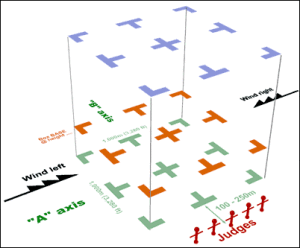 Ever since then national teams and individuals have been competing against each other by performing complex aerobatic sequences inside a designated cubic ‘box’ of sky (each side is 1000 metres long, with a safety margin of 500 metres on each dimension); the ‘ends’ of the box are marked by painted lines on the ground.
Ever since then national teams and individuals have been competing against each other by performing complex aerobatic sequences inside a designated cubic ‘box’ of sky (each side is 1000 metres long, with a safety margin of 500 metres on each dimension); the ‘ends’ of the box are marked by painted lines on the ground.
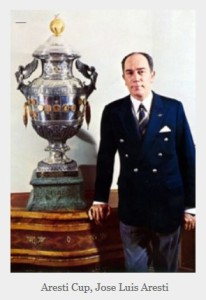 In the 1950s, a Spanish Air Force officer, Colonel José Luis Aresti Aguirre, devised a method of describing aerobatic sequences by means of a combination of simple lines, hash marks and other symbols, and published them in a ‘catalogue’. It became possible for a flyer to devise unique competition sequences, print them and fly them in front of a panel of judges, so that they could be assessed. These so-called Aresti figures replaced the short-lived Dressler system in 1962, and have become the worldwide standard since then. As with most things these days, it is possible to purchase software which will write aerobatic sequences for you! The cockpit of all competitive machines have a holder for the sequence card of Aresti figures.
In the 1950s, a Spanish Air Force officer, Colonel José Luis Aresti Aguirre, devised a method of describing aerobatic sequences by means of a combination of simple lines, hash marks and other symbols, and published them in a ‘catalogue’. It became possible for a flyer to devise unique competition sequences, print them and fly them in front of a panel of judges, so that they could be assessed. These so-called Aresti figures replaced the short-lived Dressler system in 1962, and have become the worldwide standard since then. As with most things these days, it is possible to purchase software which will write aerobatic sequences for you! The cockpit of all competitive machines have a holder for the sequence card of Aresti figures.
Extra Flugzeugbau GmbH – or, to be more correct, Extra Flugzeugproduktions-und Vertriebs GmbH, was founded in 1980 by Walter Extra, at Dinslaken/Schwarze Heide Airport, (ICAO: EDLD) near Hünxe, North Rhine-Westphalia in Germany. 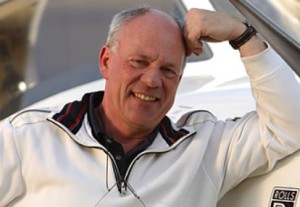 Walter Extra was a noted aerobatic pilot, having taken part in 1982 in the 11th FAI World Aerobatic Championships at Spitzerberg, Austria (the eventual winner was Victor Smolin of the USSR flying a Yak 50). Walter had decided to start designing and building aircraft which would would be competitive at the very highest level in aerobatic competitions, and take on such designs as the Russian Yak 50. His Extra 230 was a step in the right direction, but it used a wooden wing similar to that on the French aerobatic aircraft, the Mudry CAP 230.
Walter Extra was a noted aerobatic pilot, having taken part in 1982 in the 11th FAI World Aerobatic Championships at Spitzerberg, Austria (the eventual winner was Victor Smolin of the USSR flying a Yak 50). Walter had decided to start designing and building aircraft which would would be competitive at the very highest level in aerobatic competitions, and take on such designs as the Russian Yak 50. His Extra 230 was a step in the right direction, but it used a wooden wing similar to that on the French aerobatic aircraft, the Mudry CAP 230.
The scene was set for a radical redesign; the Extra aircraft up until this point in time had mainly been two-seaters, but Walter Extra decided on building a single-seater which was to be optimized for ‘Unlimited’ competitions – this would be named the Extra 300S.
 This meant that the wooden wing had to go; in its place came one of carbon fibre with a spar and integral tank of the same material. To make it even stronger, it was clad in sheets made from carbon fibre. So as to promote uniform flying characteristics, whether the aircraft was inverted or upright, the wing was manufactured with a symmetrical aerofoil section, and positioned at the mid-point of the fuselage with zero incidence. The fuselage was constructed from extremely strong welded steel tubing, clad with aluminum panels and (in some areas) fabric. The whole empennage is a carbon composite structure, and a similar material is used to form the aircraft’s control rods which transmit the movement of the flying controls to the elevators, rudder and ailerons; strangely, the ailerons are not ‘full-span’, as with other advanced aerobatic machines, but occupy about 3/4 of the trailing edge of the aircraft’s wing. Carbon fibre is even used for the main landing gear components (although the wheel fairings are glass fibre).
This meant that the wooden wing had to go; in its place came one of carbon fibre with a spar and integral tank of the same material. To make it even stronger, it was clad in sheets made from carbon fibre. So as to promote uniform flying characteristics, whether the aircraft was inverted or upright, the wing was manufactured with a symmetrical aerofoil section, and positioned at the mid-point of the fuselage with zero incidence. The fuselage was constructed from extremely strong welded steel tubing, clad with aluminum panels and (in some areas) fabric. The whole empennage is a carbon composite structure, and a similar material is used to form the aircraft’s control rods which transmit the movement of the flying controls to the elevators, rudder and ailerons; strangely, the ailerons are not ‘full-span’, as with other advanced aerobatic machines, but occupy about 3/4 of the trailing edge of the aircraft’s wing. Carbon fibre is even used for the main landing gear components (although the wheel fairings are glass fibre).
This extreme use of carbon fibre means that the whole aircraft weighs only 870 kilograms, or 1,918 lbs. Walter Extra, the designer, undertook the first flight of the Extra 300S on the 6th May, 1988.
From the first it was obvious that the aircraft would be extremely competitive, but an even more advanced version, the Extra 330SC, was developed in 2008. 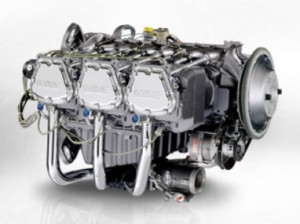 Its Lycoming AEIO-580-B1A, 6 cylinder, fuel-injected engine produces 315 hp at 2,700 rpm, and the three-bladed MTV-9-B composite propeller ensures that a startling initial climb rate of 3,200 ft/min is achieved. Other performance figures are equally impressive – 253 mph top speed and a roll rate of no less than 400° per second, which will really stress the neck muscles. Since the airframe is stressed to no less than plus/minus 23G, it can be seen that the limiting factor in any aerobatic sequence is now the human body! Needless to say, the cockpit is equipped with a Hooker safety harness with ratchet adjustment. The structure you can see mounted on the port wingtip is an aerobatic sighting device, this is used to help pilots establish vertical, horizontal, and 45-degree lines, as most of the Aresti manouvers start and finish at these angles.
Its Lycoming AEIO-580-B1A, 6 cylinder, fuel-injected engine produces 315 hp at 2,700 rpm, and the three-bladed MTV-9-B composite propeller ensures that a startling initial climb rate of 3,200 ft/min is achieved. Other performance figures are equally impressive – 253 mph top speed and a roll rate of no less than 400° per second, which will really stress the neck muscles. Since the airframe is stressed to no less than plus/minus 23G, it can be seen that the limiting factor in any aerobatic sequence is now the human body! Needless to say, the cockpit is equipped with a Hooker safety harness with ratchet adjustment. The structure you can see mounted on the port wingtip is an aerobatic sighting device, this is used to help pilots establish vertical, horizontal, and 45-degree lines, as most of the Aresti manouvers start and finish at these angles.
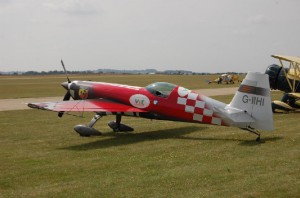 The aircraft you can see left, G-IIHI, is parked at the Duxford Airfield of the Imperial War Museum. It was built in 2008, (construction number, SC008) and is registered to Yak UK Ltd, Sandy, Bedfordshire. The pilot is the renowned Mark Jefferies, who is based at Little Gransden Airfield, which is located in the grounds of Fuller’s Hill Farm, his home. Mark has been UK aerobatics champion a total of no less than nine times, and is the leader of the Global Stars aerobatic team which displays around the world. Little Gransden is also the home of the British Aerobatic Academy, where pilots may undertake ‘dual training in the Extra 300L or solo training in the Edge 540, Extra 300S or 330SC’. Despite the fierce competition posed by such aircraft as the American-built MXS, the Sukhoi Su-26M3 and the Mudry CAP 232, an Extra 330SC, flown by the French pilot Francois Le Vot, took the ‘Unlimited’ section of the Aresti Cup competition at the recent 2013 FAI World Championships, held at the North Texas Regional Airport (ICAO: KGYI), Perrin, Texas, USA.
The aircraft you can see left, G-IIHI, is parked at the Duxford Airfield of the Imperial War Museum. It was built in 2008, (construction number, SC008) and is registered to Yak UK Ltd, Sandy, Bedfordshire. The pilot is the renowned Mark Jefferies, who is based at Little Gransden Airfield, which is located in the grounds of Fuller’s Hill Farm, his home. Mark has been UK aerobatics champion a total of no less than nine times, and is the leader of the Global Stars aerobatic team which displays around the world. Little Gransden is also the home of the British Aerobatic Academy, where pilots may undertake ‘dual training in the Extra 300L or solo training in the Edge 540, Extra 300S or 330SC’. Despite the fierce competition posed by such aircraft as the American-built MXS, the Sukhoi Su-26M3 and the Mudry CAP 232, an Extra 330SC, flown by the French pilot Francois Le Vot, took the ‘Unlimited’ section of the Aresti Cup competition at the recent 2013 FAI World Championships, held at the North Texas Regional Airport (ICAO: KGYI), Perrin, Texas, USA.
In case anyone is worried about the environmental impact of such an aerobatic machine, take comfort from the fact that the Extra’s complex ’6 into 1′ Gomolzig EA300 exhaust silencer permits it to pass a noise overflight test with a figure of 76.3 dB(A). Not only that, but the advanced smoke generation system, by FAI regulations, must be capable of using biodegradable smoke oil.
Aerobatics is exciting, graceful and immensely skillful, and is one of the most advanced forms of flying. The Extra 330SC is one of the very best competition machines available, and epitomizes this exciting sport.
Thank you to Ross Sharp of the http://peoplesmosquito.org.uk for allowing me to reprint his blog

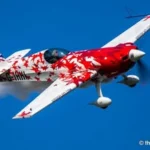

 WhatsApp me
WhatsApp me
You must be logged in to post a comment.